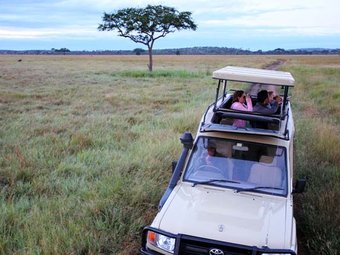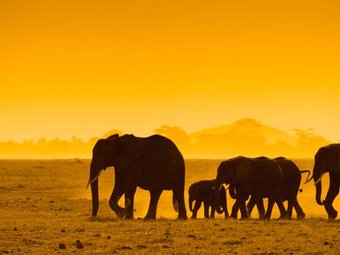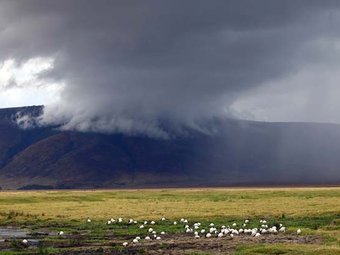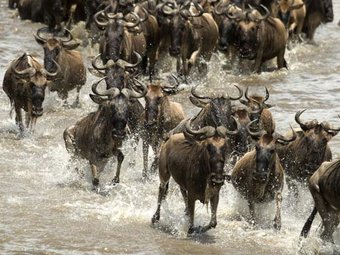Gems of Tanzania Safari
12 days—Gems of Tanzania Safari
$8000-12000 USD
pp
Safari summary
Wildlife Viewing In Tanzania: Tarangire National Park, Lake Manyara National Park, Serengeti National Park, Ngorongoro Crater
Types of Transportation: Land Cruiser
Active Options Available: Village Walking Tour, Ballooning, Canoeing, Bicycling
Cultural Experiences Available: Global Service Corps, Tanzania Sports Academy, Seva Foundation, Shanga Project
About this tour
| Tour type | Custom, tailor-made, private | |
| Main focus | Game drives | |
| Activity level | Easy activity | |
| Best months | All months | |
| Countries | ||
| Parks |
Fine details
Safari highlights
- Night game drives
Itinerary
Day 1
Day 1 Travel day International flight
Day 2
Arusha | Kilimanjaro
Day 2 Karama Lodge Arusha Pickup at Kilimanjaro Airport by Deeper Africa guide after clearing customs. He will have a sign with your name on it. Your guide will transport you to Karama Lodge for an evening meal and overnight. You’ll have a short briefing to review your safari itinerary. Overnight at Karama Lodge.
Day 3
Tarangire
Day 3 Maramboi Tented Camp Tarangire National Park Breakfast at Karama Lodge. Drive out after breakfast for Tarangire National Park, arriving at the park before lunch. Check in at Maramboi Tented Camp with lunch. Full afternoon for wildlife viewing in Tarangire. Your next nine days include in-depth opportunities to learn animal identification, wildlife tracking, and spotting wildlife in the landscape in the company of a Deeper Africa naturalist. As well, your Deeper Africa guide will begin to introduce you to East Africa conservation issues including: human wildlife conflicts, poaching conflicts and controls, as well as community involvement in wildlife conservation. Tarangire is famous for elephants. It boasts one of the largest and most conspicuous elephant populations in Africa. There are large family groups with many calves being born each year as the population has shown remarkable recovery from the devastating effects of poaching in the eighties. You will see herds of elephants, and gain up-close contacts with matriarchs, babies, teenagers, and bulls. Your close contact will help you in your understanding of these incredible animals. Spend several hours surrounded by the herds, and you cannot help but feel their wisdom. While wildlife viewing you’ll have a cool box in your Land Cruiser stocked with water and your favorite sodas. Dinner and overnight at Maramboi Tented Camp.
Day 4
Tarangire
Day 4 Maramboi Tented Camp Tarangire National Park Breakfast at Maramboi Tented Camp. Full day of wildlife viewing as scheduled with your guide. Plan your day with your guide, but consider getting a picnic lunch from the lodge and spending a full day out in the park. Tarangire contains a range of ecosystems: from grassland and woodlands in the north, to scrub and wetlands further south. The Tarangire River cuts through the park and empties into Lake Burunge in the west. As water sources dry up in the park after the end of the rainy season, animals migrate to the only permanent water available - the Tarangire River and the Silale Swamp system. Huge numbers of zebras make up the majority of the herds in Tarangire. Wildebeests, buffalos, and antelope are found as well. Dinner and overnight at Maramboi Tented Camp.
Day 5
Lake Manyara
Day 5 Serena Manyara Lake Manyara National Park Breakfast at Serena Manyara and then head out for the drive to Lake Manyara National Park. Setting against the Rift escarpment is Manyara’s evergreen groundwater forest. While it looks like a rainforest, not enough rainfall occurs to sustain this forest. Rather, mineral springs seeping through porous volcanic soil provide most of the water for the huge mahogany, tamarind, wild date palms, croton, sausage trees, and strangling figs. In additional to the evergreen groundwater forest, the park also contains a variety of ecosystems including acacia woodland, grassy plains, a swampy fan delta, and, of course, the lake. This variety attracts a wide variety of mammal, bird, and wildlife species. Flocks of flamingos are attracted to the large amounts of algae in the lake’s soda environment while the forest areas attract large flocks of pelicans, storks, herons, ibis, and egrets. Bird watching is spectacular at Manyara, with over 380 bird species recorded. As well, the primate viewing which includes blue monkeys, vervet monkeys, and very active baboon troops is quite enjoyable. Elephant, buffalo, impala, bushbuck, waterbuck, hippos, and lots of elephants roam near the lake. There are sightings of klipspringers on the rocky escarpments on the southern side of the rift wall. Dinner and overnight at Serena Manyara.
Day 6
Serengeti
Day 6 Dunia Camp Serengeti National Park Breakfast at Kirurumu Tented Camp. Head out after breakfast for the drive to Serengeti National Park. Picnic lunch at Oldupai Gorge while you stop to visit the famous Leakey digs. The Rift Valley was home to the first humans, and the Leakey family has successfully excavated some of the oldest humanoid skeletons ever discovered. Many people believe that Oldupai is the birth place of humanity. You’ll visit the onsite museum and hear a short lecture about the gorge from the resident anthropologist. Once you enter the Serengeti you will begin wildlife viewing traveling the distance to Dunia Camp. The word ‘Serengeti’ is derived from the Maasai language, meaning endless plain. This vast savannah grass land extends northward into the Maasai Mara in Kenya for over five thousand square miles of land, forming one of the world’s largest wildlife refuges. This is land as it was in the beginning: no fences, no settlements, just a perennial migration of wildlife. In a journey that reaches back through time, these herds of animals follow the seasonal rains, traveling from the Serengeti into the Mara instinctually moving with the seasonal rainfalls. The annual migration is what makes the Serengeti famous. The herds gather on the Tanzanian side of the ecosystem from sometime in November or December through early July. The migration includes vast herds of wildebeest, but also zebra and Thomson’s gazelle. The herds steadily move southward through April or May when the seasonal rains cause them to turn and begin the journey back northward toward the Maasai Mara. Wildebeest are well suited to harvest the short grasses that cover the semiarid plans of the Serengeti. The soils of this region have an underlying hard pan covered by a fertile layer of volcanic soil. Grass growing in this soil is highly nutritious taking up nutrients trapped by the hard pan. Arrive at our Dunia Camp in the afternoon for Sundowners (“drinks at sundown”), a luscious dinner, and overnight.
Day 7
Serengeti
Day 7 Dunia Camp Serengeti National Park Set your wildlife viewing schedule as you choose with your guide. Park permits allow you wildlife viewing from 6 am to 6 pm. Choices for wildlife viewing include: Morning and afternoon wildlife viewing with lunch at Dunia Camp; All day wildlife viewing with picnic lunch; or wildlife viewing out before sunrise with return for brunch and afternoon wildlife viewing. In addition to the migration herds there are large numbers of resident game in several different areas of the Serengeti. Breakfast, lunch, and dinner at Dunia Camp.
Day 8
Serengeti
Day 8 Dunia Camp Serengeti National Park Full day of wildlife viewing as scheduled with your guide. Unlike the migration herds, predators are territorial, remaining in their home territory all year long. Wildlife populations double during the migration season, but that still means that resident wildlife populations are some of the densest on the African continent. They include substantial populations of plain’s game including buffalo, giraffe, and warthog; as well as a wide range of antelope species including dik dik, bushbuck, waterbuck, eland, impala, and topi. Breakfast, lunch, and dinner at Dunia Camp.
Day 9
Ngorongoro Crater | Serengeti
Day 9 Tloma Lodge Ngorongoro Conservation Area Breakfast at camp. Pack up and begin the drive into the Ngorongoro Conservation Area with your wildlife viewing continuing as you leave the Serengeti. Picnic lunch along the way. As you enter the Ngorongoro Conservation Area you will begin to see Maasai enkangs (“homesteads”). The Maasai enjoy special land use in the Conservation Area which allows them to live their traditional pastoral lifestyle, coexisting amongst the wildlife. There is substantial wildlife in the Conservation Area so your cultural views will be mixed with wildlife observation. Note the changes in vegetation as you begin the climb up the slopes of the Ngorongoro Crater. The savannahs disappear into lush, more tropical vegetation, including vast coffee plantations. Ngorongoro National Park begins on the Crater Rim and the vast exploded caldera is at the bottom of the Crater. Even though it is parkland the Maasai are still allowed to graze their cattle in the Crater. You will often see young herders and their cattle moving in the morning and evening hours. The Crater is an expansive environment inside an extinct volcano. The view from the Crater Rim is spectacular so stop at one of the view points after you reach the Crater rim at 7,500 feet (2286 meters). Dinner and overnight at Tloma Lodge.
Day 10
Day 10 Tloma Lodge Ngorongoro Conservation Area Breakfast at Tloma Lodge followed by wildlife viewing in the Crater. The Crater floor is mostly grasslands, so wildlife visibility is excellent, providing a wonderful opportunity for photography. Zebra, wildebeest, and gazelle mingle together, while herds of buffalo graze the long grass areas. Bull elephants and rhino are often seen feeding in green marshes, and there are plenty of hyenas. Hippos lounge in the water holes and it is not uncommon to see lions. Dinner and overnight at Tloma Lodge.
Day 11
Arusha | Kilimanjaro
Day 11 Kia Lodge Near Kilimanjaro Airport Breakfast at Tloma Lodge. Begin your journey back to Arusha after breakfast. You will arrive in Arusha in the early afternoon for lunch at the Shanga River House. Learn more about the great work being done by Shanga Project www.shanga.org. Shopping for craft items or sightseeing in Arusha town after lunch. Check in for a day room at Kia Lodge by mid-afternoon. The afternoon is for packing, showering, and relaxing. Early dinner at Kia Lodge. Pickup for transport to your international flight at Kilimanjaro Airport.
Day 12
Day 12 Travel day International flight 4
Here are the latest tours by Deeper Africa.
Tanzania Southern Circuit
Tour by: Deeper Africa
Countries:

Focus: Game drives
Elephant Walk Safari
Tour by: Deeper Africa
Countries:

Focus: Game drives
Wild Tanzania Safari
Tour by: Deeper Africa
Countries:

Focus: Game drives
Maasai Mara Safari
Tour by: Deeper Africa
Countries:

Focus: Game drives
Cleanliness of vehicle
Meet and greet team
Quality of itinerary
Responsiveness of staff




